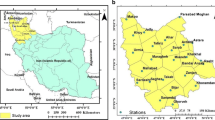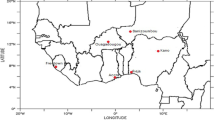Abstract
The possible anthropogenic aerosol effect on regional precipitation is analyzed based on the historical data of precipitation and visibility of North China. At first, the precipitation amounts from 1960 to 1979 are considered as natural background values in our study for relatively less intensive industrial activities and light air pollution during that period of time, then the region is divided into different subregions by applying the clustering method including the significance test of station rainfall correlations to the time series of 10-day mean rainfall amounts in this period. Based on the rule that the precipitation characteristics are similar in the same clustering region, the correlation of precipitation amounts among all stations in each region is thus established. Secondly, for the period from 1990 to 2005, during which, the economy had experienced a rapid development in this region, the variations of visibility at each station are analyzed. The stations with the absolute change in visibility less than 0.1 km/a are used as the reference stations, at which it is assumed that precipitation has not been seriously influenced by anthropogenic aerosols. Then the rainfall amounts of reference stations are used to estimate the natural precipitation values of the other stations in each clustering region. The difference between estimated precipitation and measured precipitation amount is thought to result from changes in anthropogenic aerosols. These changes in precipitation amounts caused by anthropogenic aerosols at each station are calculated using the 10-day mean rainfall values from 1990 to 2005. The analysis results obtained with this method are remarkable if it passes the significance test, and therefore, the suppression of regional precipitation over the region by anthropogenic aerosol is proved. It is found that this effect is most remarkable in summer. The influence of anthropogenic aerosols on convective precipitation possibly plays an important role in this season.
Similar content being viewed by others
References
Ramanathan V, Crutzen, P J, Kiehl J T, et al. Aerosols, climate and the hydrological cycle. Science, 2001, 294(5549): 2119–2124
Wang M X. Atmospheric Chemistry, 2nd ed. (in Chinese). Beijing: China Meteorological Press, 2005. 314
Jin F. Advance and application in cloud physic (in Chinese). Meteor Sci Tech, 1974, 5: 20–25
Albrecht B A. Aerosols, cloud microphysics, and fractional cloudiness. Science, 1989, 245(4923): 1227–1230
King M D. Radiative properties of clouds. In: Hobbs P V, ed. Aerosol-Cloud-Climate Interactions. Int Geophys Ser San Diego. Calif: Academic Press, 1993. 54: 123–149
Ferek R J, Hegg D A, Hobbs P V, et al. Measurements of ship-induced tracks in clouds off the Washington coast. J Geophys Res, 1998, 103(D18): 23199–23206
Rosenfeld D. Suppression of rain and snow by urban and industrial air pollution. Science, 2000, 287(5459): 1793–1796
Heymsfield A J, McFarquhar G M. Microphysics of INDOEX clean and polluted trade cumulus clouds. J Geophys Res, 2001, 106(D22): 28653–28674
Yum S S, Hudson J G. Maritime-continental microphysical contrasts in stratus. Tellus B, 2002, 54(1): 61–73
Menon S, Hansen J, Nazarenko L, et al. Climate effects of black carbon aerosols in China and India. Science, 2002, 297(5590): 2250–2253
Giorgi F, Bi X Q, Qian Y. Indirect vs. direct effects of anthropogenic sulfate on the climate of East Asia as simulated with a regional coupled climate-chemistry-aerosol model. Clim Change, 2003, 58(3): 345–376
Ackerman A S, Kirkpatrick M P, Stevens D E, et al. The impact of humidity above stratiform clouds on indirect aerosol climate forcing. Nature, 2004, 432: 1014–1017
Takemura T, Nozawa T, Emori S, et al. Simulation of climate response to aerosol direct and indirect effects with aerosol transport-radiation model. J Geophys Res, 2005, 110: D02202, doi: 10.1029/2004JD005029
Yin Y, Chen L. The effects of heating by transported dust layers on cloud and precipitation: A numerical study. Atmos Chem Phys, 2007, 7: 3497–3505
Huang Y, Chameides W L, Dickinson R E. Direct and indirect effects of anthropogenic aerosols on regional precipitation over east Asia. J Geophys Res, 2007, 112: D03212, doi: 10.1029/2006JD007114
Zhao C S, Tie X X, Lin Y P. A possible positive feedback of reduction of precipitation and increase in aerosols over eastern central China. Geophys Res Lett, 2006, 33: L11814, doi: 10.1029/2006GL025959
Chen L X, Zhou X J, Li W L, et al.Characteristics of the climate change and its formation mechanism in China in the last 80 years (in Chinese). Acta Meteor Sin, 2004, 62(5): 634–645
Charlson R J. Atmospheric visibility related to aerosol mass concentration: Review. Environ Sci Technol, 1969, 3(10): 913
Appel B R, Tokiwa Y, Hsu J, et al.Visibility as related to atmospheric aerosol constituents. Atmos Environ, 1985, 19(9): 1525–1534
Qiu J H, Yang L Q. Variation characteristics of atmospheric aerosol optical depths and visibility in North China during 1980–1994. Atmos Environ, 2000, 34(4), 603–609
Vinzani P G, Lamb P J. Temporal and spatial visibility variations in the illinois vicinity during 1949–80. J Appl Meteor, 1985, 24(5): 435–451
Cheng C M, Chan C C, Chan S T. Visibility trends in Hong Kong. HK MetS Bull, 1997, 7(1): 3–21
Doyle M, Dorling S. Visibility trends in the UK 1950–1997. Atmos Environ, 2002, 36(19): 3161–3172
Tsai Y I. Atmospheric visibility trends in an urban area in Taiwan 1961–2003. Atmos Environ, 2005, 39(30): 5555–5567
Ghim Y S, Moon K C, Lee S, et al. Visibility trends in Korea during the past two decades. J Air Waste Manage Assoc, 2005, 55(1): 73–82
Fan Y Q, Li E J, Fan Z L.Visibility trends in 11 cities of Hebei Province during 1960–2002 (in Chinese). Chin J Atmos Sci, 2005, 29(4): 526–535
Rosenfeld D, Dai J, Yu X, et al. Inverse relations between amounts of air pollution and orographic precipitation. Science, 2007, 315(5817): 1396–1398
IPCC. Fourth Assessment Report: Climate Change 2007- the Scientific Basic. Cambridge: Cambridge University Press, 2007
Li C C, Mao J T, Lau K-H A, et al. Characteristics of distribution and seasonal variation of aerosol optical depth in eastern China with MODIS products. Chin Sci Bull, 2003, 48(22): 2488–2495
Editorial Committee of National Assessment Report on Climate Change. Chinese national assessment report on climate change (summary) (in Chinese). World Environ, 2007, 2: 23–33
Shi G Y, Xu L, Guo J D, et al. Balloon observation of atmospheric ozone and aerosols (in Chinese). Chin J Atmos Sci, 1996, 20(4): 401–407
Yang K. Characteristics of atmospheric Aerosol Optical Depth over China during 1981–2003 (in Chinese). Dissertation for the Master’s Degree. Nanjing: Nanjing University of Information Science and Technology, 2007. 27–28
Yao Z S. Cluster analisis used in numerical classification (in Chinese). Trans Oceanol Limnol, 1994, 2: 1–12
Zhai Y. Improvement on statistical evaluation method of artificial precipitation enhancement effects (in Chinese). Dissertation for the Master’s Degree. Nanjing: Nanjing University of Information Science and Technology, 2006. 14–19
Su J Q, Cheng S L, Guo Y C. Climate of Hebei Province (in Chinese). Beijing: China Meteorological Press, 1996. 20
Wang S Y, Zhang X L, Xu X F. Analysis of variation features of visibility and its effect factors in Beijing (in Chinese). Meteor Sci Tech, 2003, 31(2): 109–114
Ye D, Jiang C T, Wang F. Characteristics of atmospheric visibility and its controlling factors in Chongqing (in Chinese). J Meteor Environ, 2006, 22(6): 6–10
Ye J D, Fan B F. Statistical Methods in Weather Modification Research (in Chinese). Beijing: Science Press, 1982. 158
Yin Y, Carslaw K S, Feingold G. Vertical transport and processing of aerosols in a mixed-phase convective cloud and the feedback on cloud development. Q J Roy Meteor Soc, 2005, 131(605): 221–246
Author information
Authors and Affiliations
Corresponding author
Additional information
Supported by National Basic Research Program of China (Grant No. 2006CB403706) and National Natural Science Foundation of China (Grant No. 40475003)
About this article
Cite this article
Duan, J., Mao, J. Influence of aerosol on regional precipitation in North China. Chin. Sci. Bull. 54, 474–483 (2009). https://doi.org/10.1007/s11434-008-0447-6
Received:
Accepted:
Published:
Issue Date:
DOI: https://doi.org/10.1007/s11434-008-0447-6




